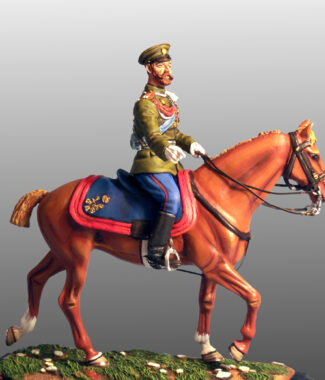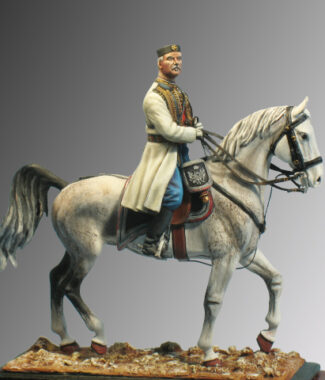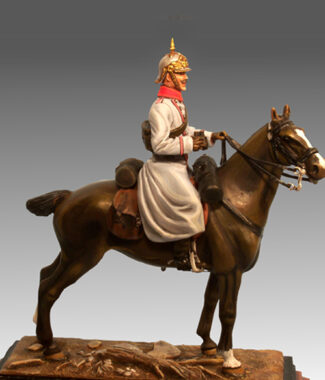You must be logged in to post a review.
€68.00
Figure to assemble and paint
Ref.: 08 – RE
Weight: 250 grs.
Material: White Metal
Number of Pieces: 12
Historical Review:
Victor Emmanuel III (Naples, Italy, November 11, 1869 – Alexandria, Egypt, December 28, 1947) was King of Italy (July 29, 1900 – May 9, 1946).
He succeeded his father Umberto I in 1900 when he was assassinated at Monza. He received, as was common in the princes of his time, military training, taking into account that he had already shown special interest in military affairs, but due to his short stature, 1.53 m., military legislation had to be changed. In this regard.
During his reign, Italy tried to increase its still incipient Italian colonial empire and also increase its national territory, which led the country to be involved in several conflicts: at first, it launched the Italo-Turkish War in 1911–1912 with the which Italy managed to take over the Turkish territories of Tripolitania and Cyrenaica in North Africa, then participated in the First World War (1915-1918) on the allied side, managing to annex Trentino and Alto Adige, regions with an Italian population but ruled by Austria.
During the first two decades of his reign, Victor Emmanuel III acted within the limits set by the Constitution and did not interfere in the actions of successive governments, including the liberals of Giovanni Giolitti and the conservatives of Antonio Salandra, allowing parliamentarism to develop. But in 1922, faced with the violent pressure exerted on the government by the March on Rome organised by the still young Fascist movement led by Benito Mussolini, the monarch did not agree to declare a state of siege as requested by Prime Minister Luigi Facta and, on 30 October, the king accepted Mussolini’s appointment as prime minister, in violation of his constitutional powers. With Mussolini in power, the monarch neither opposed nor even expressed an opinion on the dismantling of the constitutional system and the imposition of the totalitarian Fascist regime in 1925.
Later, with the Italian victory in the Ethiopian War (1935-1936), Victor Emmanuel III was proclaimed Emperor of Ethiopia (1936-1941) and King of Albania (1939-1943), after the latter country was occupied by Italy in April 1939 but was only recognised as such by the allies of Italian Fascism. Precisely because of his conquest of Ethiopia, Italy was subject to sanctions by the League of Nations. Under his reign, Italy also took part in the Spanish Civil War (1936-1939), supporting the rebel side led by Francisco Franco.
Nor did Victor Emmanuel III object when Mussolini began his alliance with Nazi Germany in 1936 or when the Pact of Steel was signed in 1939, justifying Italy’s entry into World War II in June 1940. This prevented any room for manoeuvre for the monarch, who remained head of state with representative functions, without any option of taking political initiatives. Victor Emmanuel III did not try to prevent or show any reservations about the crimes of fascism, although from 1941 he began to resent the excessive influence of the Third Reich in Italy’s internal affairs, but his opposition remained in words and did not translate into action.
Aware of the rejection he provoked among the Italian population, Victor Emmanuel III tried to safeguard the continuity of the House of Savoy by abdicating on 9 May 1946 in favour of his son and heir Humbert II. Despite this, Victor Emmanuel’s disrepute in his final years meant that, in the referendum held on 2 June 1946, the majority of Italians opted for the Republic.
After his abdication, Victor Emmanuel of Savoy went into exile under the name of Conte di Pollenzo and died a year later in Alexandria, Egypt, where he was buried in the Church of Saint Catherine.
The figure is based on a series of photographs taken on the occasion of Victor Emmanuel III’s visit to Tsar Nicholas II in 1902. The two monarchs can be seen reviewing the Russian Imperial Guard Division. He wears the parade uniform of a general of the Italian Army. For this visit he rides a horse corresponding to the Tsar’s own escort.






Reviews
There are no reviews yet.